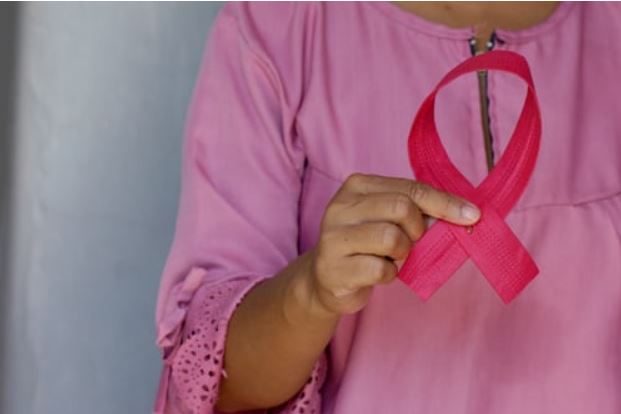Overview
Breast cancer is cancer that develops in breast cells. Typically, the cancer forms in either the lobules or the ducts of the breast. Lobules are the glands that produce milk, and ducts are the pathways that bring the milk from the glands to the nipple. Cancer can also occur in the fatty tissue or the fibrous connective tissue within the breast.
The uncontrolled cancer cells often invade other healthy breast tissue and can travel to the lymph nodes under the arms. The lymph nodes are a primary pathway that helps the cancer cells move to other parts of the body. Breast cancer can spread outside the breast through blood vessels and lymph vessels. When breast cancer spreads to other parts of the body, it is said to have metastasized.
Cause
Breast cancer risk factors are things that increase the chance that you could develop breast cancer:
• Some risk factors you can control, such as drinking alcohol. Others, such as family history, you cannot control.
• The more risk factors you have, the more your risk increases. But, it does not mean you will develop cancer. Many women who develop breast cancer do not have any known risk factors or family history.
• Understanding your risk factors can help you take steps to lower your risk.
Some women are at higher risk for breast cancer because of certain genetic markers or variants that may be passed down from their parents.
• Genes known as BRCA1 or BRCA2 are responsible for most cases of inherited breast cancers.
• A screening tool with questions about your family’s history as well as yours can help your health care provider whether you are at risk for carrying these genes.
• If you are at high risk, a blood test to see if you carry the genes.
• Certain other genes may lead to an increased risk of breast cancer.
Breast implants, using antiperspirants, and wearing underwire bras do not increase the risk for breast cancer. There is also no evidence of a direct link between breast cancer and pesticides.
Symptoms
Different people have different symptoms of breast cancer. Some people do not have any signs or symptoms at all.
Some warning signs of breast cancer are:
•New lump in the breast or underarm (armpit).
•Thickening or swelling of part of the breast.
•Irritation or dimpling of breast skin.
•Redness or flaky skin in the nipple area or the breast.
•Pulling in of the nipple or pain in the nipple area.
•Nipple discharge other than breast milk, including blood.
•Any change in the size or the shape of the breast.
•Pain in any area of the breast.
These symptoms can happen with other conditions that are not cancer.
Treatment
Breast cancer is treated in several ways. It depends on the kind of breast cancer and how far it has spread. People with breast cancer often get more than one kind of treatment.
Surgery. An operation where doctors cut out cancer tissue.
Chemotherapy. Using special medicines to shrink or kill the cancer cells. The drugs can be pills you take or medicines given in the veins, or sometimes both.
Hormonal therapy. Blocks cancer cells from getting the hormones they need to grow.
Biological therapy. Works with the body’s immune system to help it fight cancer cells or to control side effects from other cancer treatments.
Radiation therapy. Using high-energy rays (similar to X-rays) to kill the cancer cells.
Other
Exams and Tests
The health care provider will ask about your symptoms and risk factors. Then the provider will perform a physical exam. The exam includes both breasts, armpits, and the neck and chest area.
Women are encouraged to perform breast self-exams each month. However, the importance of self-exams for detecting breast cancer is debatable.
Tests used to diagnose and monitor people with breast cancer may include:
• Mammography to screen for breast cancer or help identify the breast lump
• Breast ultrasound to show whether the lump is solid or fluid-filled
• Breast biopsy, using methods such as needle aspiration, ultrasound-guided, stereotactic, or open
• Breast MRI to help better identify the breast lump or evaluate an abnormal change on a mammogram
• Sentinel lymph node biopsy to check if cancer has spread to the lymph nodes
• CT scan to check if cancer has spread outside the breast
• PET scan to check if cancer has spread
If your doctor learns that you do have breast cancer, more tests will be done. This is called staging, which checks if cancer has spread. Staging helps guide treatment and follow-up. It also gives you an idea of what to expect in the future.
Breast cancer stages range from 0 to IV. The higher the stage, the more advanced cancer.
Mammogram
A mammogram is an X-ray picture of the breast. Doctors use a mammogram to look for early signs of breast cancer. Regular mammograms are the best tests doctors have to find breast cancer early, sometimes up to three years before it can be felt.
Source
https://www.healthline.com/health/breast-cancer
https://www.webmd.com/breast-cancer/understanding-breast-cancer-symptoms
https://www.cdc.gov/cancer/breast/basic_info/mammograms.htm
https://www.cdc.gov/cancer/breast/basic_info/treatment.htm



